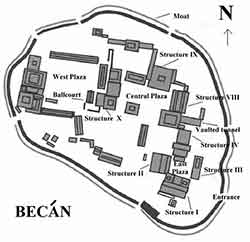Land of the Maya
Becán


Becán, meaning "path of the serpent." or maybe "ditch of water" is one of the most fascinating sites in the Yucatan. Becán is located near the center of the Yucatán Peninsula, in the state of Campeche, about 150 km north of Tikal, Guatemala. It was re-discovered in 1934 by Karl Ruppert.
Archeological evidence shows that Becán was occupied in the middle Pre-Classic period about 550 BC, and grew to a major population and ceremonial center a few hundred years later in the late Pre-classic period. The population and scale of construction declined in the early classic period (c 250 AD), although it was still a significant site.
What makes Becán so interesting is that it is an excellent example of Maya fortification. Between AD100 and 250, a defensive ditch or moat was dug surrounding the ceremonial city and reservoirs. The dirt from the ditch was piled up to create a fortified wall around the city. Construction of major buildings and monuments stopped about 830 AD. Although the site continued to be occupied for some time thereafter, the population went into decline and Becán was abandoned by about 1200 AD.
